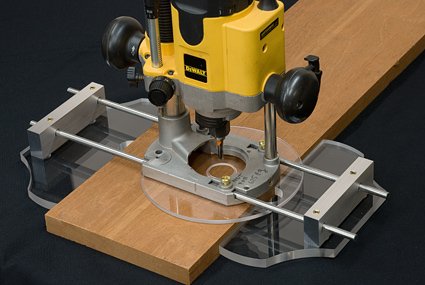The Woodworking Router Guide
The wood router is one of the most versatile tools in the woodworking shop; a huge assortment of router bits allows this popular power tool to be used for various applications. From decorative edges to a simple round over, the wood router can do it all.
The woodworkers guide to routers is a treasure chest for artisans. This page will teach you all about wood routers. It is packed with facts, tips, and information for woodworkers.
What is A Wood Router?
A router is a woodworking tool used to rout out an area in a piece of wood. It is able to cut grooves, edge molding, and chamfer or radius the edge of a piece of wood. It is also used for mortise and tenons, dowel joints, tongue and groove joints, box joints, and dovetails. The size and shape of the router bit and the depth relevant to the base determine the shape of cut that is created.
Consisting of a base, this houses a vertically mounted motor with a collet on the end of its shaft. The bit is mounted to the collet and is adjustable to allow protrusion through an opening in a flat sole plate, usually via adjusting the motor-mounting height. Control of the router is derived from a handle or knob on each side of the device.
Know the Facts about Woodworking Routers before Making a Purchase
Woodworkers have it easy these days with new advances in power tool technology. Wood routers are lighter and more accurate today than ten years ago. This page will review the top sellers and the latest technology providing you with information so you can compare the best wood routers.
Fixed-Base V.S. Plunge-Base
The two basic types of wood routers are plunge and fixed. With a fixed-base router, the cut depth is set before the tool is turned on. The plunge-base router has stops that allow the extent of the plunge to be gauged. In each case, the bit cuts its way in, although the bit used in a plunge base must be shaped so it bores into the wood when lowered.
Plunge routers are best for grooves, mortises, template pattern work, stopped dadoes, and through cuts. However, the drawbacks are it’s top heavy and the handles are harder to adjust and maneuver. The fixed-base routers are preferred for their compact designs and ease of use.
Make sure to understand collet size as well as horsepower of a router before purchasing one. Collet size is generally ¼” to ½,” while motors can range from less than 1HP to more than 1 ¾ HP. A light-duty ¼” collet with less than 1HP motor is typically for occasional use. While the ½” collet 1 ¾ HP motor is designed for everyday use of professional woodworkers.
The Best Wood Routers
Here is a list of the best wood routers on the market today, fixed and plunge base routers, all from top manufacturers.
DeWalt DW618 2-1/4 HP Router with Soft Start
The DW618 Includes:
- Microfine depth adjustment ring provides precise 1/64″ increments and adjusts vertically
- Spindle lock and flat top
- Clear, Lexan sub-base
- Self-releasing slotted collets for better bit retention and eliminating “frozen” bits
- Low center of gravity
- Quick release motor latches
- Includes fixed base, 1/4″ and 1/2″ collets, sub-base gaugeSpecifications:
- Motor 2-1/4 HP, 12 amp
- Speed 8,000 – 24,000 RPM
- Base diameter 6″
- Collet capacity 1/4″, 1/2″
- Weight 7.2 lbs.




